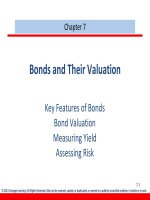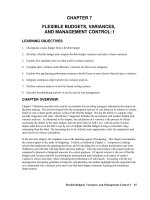Chapter 07 dimensioning
Bạn đang xem bản rút gọn của tài liệu. Xem và tải ngay bản đầy đủ của tài liệu tại đây (676.83 KB, 59 trang )
Chapter 7
Dimensioning
TOPICS
Introduction
Dimensioning components
Dimensioning object’ s features
Placement of dimensions.
Introduction
ENGINEERING DESIGN
PROCESS
RESULT
Design
a part
Sketches
of ideas
Create
drawings
Multiview
Drawing
Dimensioning
Manufacture
TRANSFERRED
INFORMATION
Shape
1. Size, Location
2. Non-graphic information
DEFINITION
Dimensioning is the process of specifying part’ s
information by using of figures, symbols and notes.
This information are such as:
1. Sizes and locations of features
2. Material’s type
3. Number required
4. Kind of surface finish
5. Manufacturing process
6. Size and geometric tolerances
This course
DIMENSIONING SYSTEM
1. Metric system : ISO and JIS standards
Examples 32, 32.5, 32.55, 0.5 (not .5) etc.
2. Decimal-inch system
Examples 0.25 (not .25), 5.375 etc.
3. Fractional-inch system
3
1
,
Examples
5
4
8
etc.
This
course
Dimensioning
Components
DIMENSIONING COMPONENTS
Extension lines
Dimension lines
(with arrowheads)
Drawn with
4H pencil
Leader lines
Dimension figures
Notes :
- local note
- general note
Lettered with
2H pencil.
EXTENSION LINES
indicate the location on the object’s features that
are dimensioned.
DIMENSION LINES
indicate the direction and extent of a dimension, and
inscribe dimension figures.
27
o
123
13
10
43
LEADER LINES
indicate details of the feature with a local note.
27
10 Drill, 2
Holes
R16
o
123
13
10
43
Recommended
Practices
EXTENSION LINES
Leave a visible gap (≈ 1 mm) from a view and
start drawing an extension line.
Extend the lines beyond the (last) dimension line
1-2 mm.
COMMON MISTAKE
Visible gap
EXTENSION LINES
Do not break the lines as they cross object lines.
COMMON MISTAKE
Continuous
DIMENSION LINES
Dimension lines should not be spaced too close
to each other and to the view.
34
11
35
16
Leave a space at least
2 times of a letter height.
Leave a space at least
1 time of a letter height.
DIMENSION FIGURES
The height of figures is suggested to be 2.5~3 mm.
Place the numbers at about 1 mm above dimension
line and between extension lines.
11
34
11
34
COMMON MISTAKE
DIMENSION FIGURES
When there is not enough space for figure or
arrows, put it outside either of the extension lines.
Not enough space
for figures
16.25
16.25
Not enough space
for arrows
1
1
1
or
DIMENSION FIGURES : UNITS
The JIS and ISO standards adopt the unit of
Length dimension in millimeters without
specifying a unit symbol “mm”.
Angular dimension in degree with a symbol “o”
place behind the figures (and if necessary
minutes and seconds may be used together).
DIMENSION FIGURES : ORIENTATION
1. Aligned method
The dimension figures are placed so that they
are readable from the bottom and right side of
the drawing.
2. Unidirectional method
The dimension figures are placed so that they
can be read from the bottom of the drawing.
Do not use both system on the same drawing or
on the same series of drawing (JIS Z8317)
EXAMPLE : Dimension of length using aligned method.
30
30
30
30
30
30
30
30
EXAMPLE : Dimension of length using unidirectional method.
30
30
30
30
30
30
30
30
EXAMPLE : Dimension of angle using aligned method.
45o
45
o
o
45
45
o
45o
45o
o
45
45o
EXAMPLE : Dimension of angle using unidirectional method.
45o
45o
45o
45o
45o
45o
45o
45o
LOCAL NOTES
Place the notes near to the feature which they
apply, and should be placed outside the view.
Always read horizontally.
10 Drill
≈ 10mm
10 Drill
Too far
10 Drill
COMMON MISTAKE
Dimensioning
Practices









